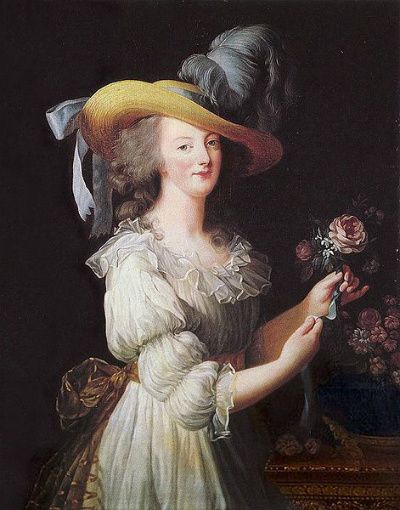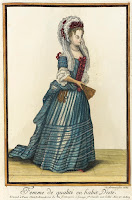Made famous by Marie Antoinette who preferred to wear at her retreat of Petit Trianon, it sparked a scandal when Elisabeth Vigée Le Brun painted the Queen wearing the informal dress.
It became fashionable during the late 1770's to early 1780's and at the time most courtiers thought that it resembled more a chemise in the traditional sense - that is basically underwear.
The chemise à la Reine is made of several layers of white muslin which is loosely draped around the wearer's body. A coloured sash was bound around the bust and this was often the only colourful element in this dress. As for the shape, it was completely different from the elaborate dresses usually worn at court. Gone were the wide panniers and rustling silks with delicate embroidery.
The inspiration is believed to have come from dresses worn by washerwomen from the West Indies; the muslin was often imported from India.
Surprisingly enough, the Queen's fashion statement was equally detested by courtiers and commoners alike. For once they could agree on one thing: the Queen of France was the fashion symbol of the Western world as well as an outward symbol of the glory of France. She could not be seen wearing such a simple style.
Still, the style spread through Europe and became popular among many a noble ladies. Marie Antoinette's personal friend, the Duchess of Devonshire, wore a chemise à la Reine for an official ball while Princess Louise Augusta of Denmark had her portrait painted in one.
It is rather ironic that the cut of the chemise à la Reine would later be associated with the post-Revolutionary France where a high waistline was the fashion.
It became fashionable during the late 1770's to early 1780's and at the time most courtiers thought that it resembled more a chemise in the traditional sense - that is basically underwear.
The chemise à la Reine is made of several layers of white muslin which is loosely draped around the wearer's body. A coloured sash was bound around the bust and this was often the only colourful element in this dress. As for the shape, it was completely different from the elaborate dresses usually worn at court. Gone were the wide panniers and rustling silks with delicate embroidery.
 |
| Marie Antoinette's portrait that caused such a fuss |
The inspiration is believed to have come from dresses worn by washerwomen from the West Indies; the muslin was often imported from India.
 |
| The Princesse de Lamballe |
Surprisingly enough, the Queen's fashion statement was equally detested by courtiers and commoners alike. For once they could agree on one thing: the Queen of France was the fashion symbol of the Western world as well as an outward symbol of the glory of France. She could not be seen wearing such a simple style.
Still, the style spread through Europe and became popular among many a noble ladies. Marie Antoinette's personal friend, the Duchess of Devonshire, wore a chemise à la Reine for an official ball while Princess Louise Augusta of Denmark had her portrait painted in one.
 |
| Louise Augusta of Denmark |
It is rather ironic that the cut of the chemise à la Reine would later be associated with the post-Revolutionary France where a high waistline was the fashion.


_by_Maurice_Quentin_de_La_Tour.png)









































































